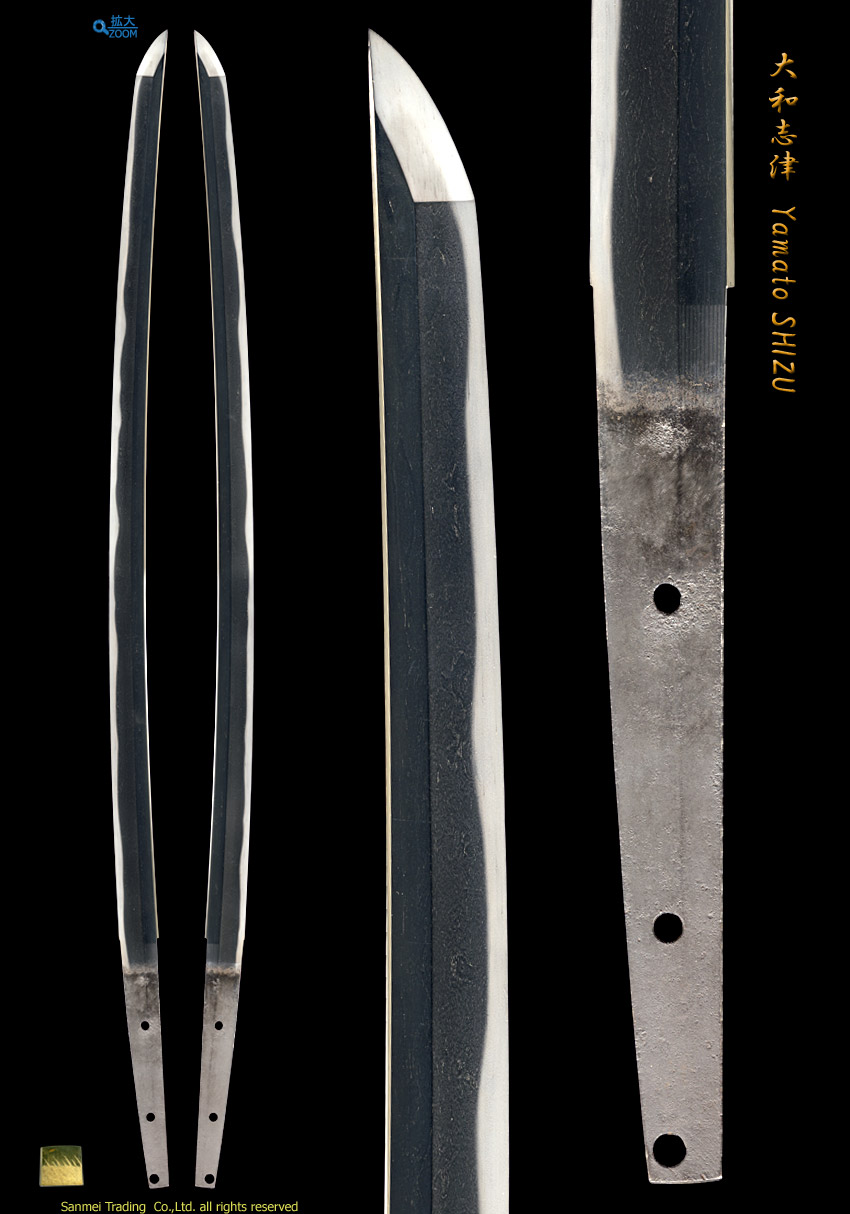Length of cutting edge 69.2cm Curvature 1.3cm Width of base 29.0mm Width of Yokote 20.5mm Thickness of base 6.6mm
Forging(Hada): Forging is conspicuous Itame with Mokume mixing flowing Masame straight. A bit on coarse side Ji-nie granules attach on surface that emits sparkling reflection of Nie. Darkish lines of Nie so called "CHIKEI" activity that outstandingly wells out from steel.
Temper(Hamon): Hamon is a bit on coarse side Nie hard metal granules base, Notare sedate wave outline, Gunome indication appears, where the feet of Gunome stream toward the cutting edge frequently. The quenching activities such as Uchinoke, Niju-ha, Kuichigai intensively run along temper line and Yubashiri activity splits onto the Hiraji. The interior of temper is filled with mist-like crystallize area deeply with short lines of nie SUNAGASHI and bright thick line like threadlike KINSEN areas. The entire temper is full of rich "Nie" hard metal granule activities which is energetic, vividly bright and clear.
Temper of tip(Boshi): Temper of boshi in front forms straight, medium circle whose tip works with brushing Hakikake activity and the reversed side forms large circle with intensive Hakikake brushing like a blaze.
Tang(Nakago): The tang is substantially shortened "Ōsuriage" to be unsigned with horizontal (Kiri) heel shape. Three peg holes with greatly slanting left (O-sujikai) filemarks.
This is the superb blade which is attributed to a work of Yamato Shizu school 大和志津 holding classical brave shape from early Nanbokucho period.
The founder of Yamato Shizu school in end Kamakura period is KANEUJI 包氏 who used to be active under Tegai school in Yamato province. He had learned the latest frontier technique from the famed smith MASAMUNE 正宗 in Soshu in order to meet with the demands of the times.
He successfully acquired the new skills and had become nominated as one of the ten genius smiths of MASAMUNE then moved to Shizu-town, Tagi-gun, Mino province to change his smith name from KANEUJI 包氏 to KANEUJI 兼氏 using a different letter but same pronunciation with the pseudonym of Shizu Zaburo 志津三郎.
Those works made by KANEUJI 包氏 who stayed in Yamato province in his earlier days, or next generation of KANEUJI 包氏 and it's school has been called Yamato Shizu 大和志津.
The workmanship of Yamato Shizu works, to sum up, inherited the mainstream of Yamato technique but adopted the most updated method from Soshu school. This katana is a superb example to show the classic traditional features from Yamato school such as a bit on high side Shinogi-ridge, Masame flowing indication of forging and Hotsure, Niju-ha quenching activities and Hakikake brushing temper of Boshi. Quenching method of a bit coarse side Nie granules, Outstanding Itame forging marks and Sedate Notare wave Hamon - those are strongly influenced from Soshu method.
In view of this blade, there are rich activities of condensed Nie in the interior of temper which makes up vividly bright impression. Jigane forms conspicuous large indication of Itame and Mokume among flowing streams of Masame activity but are moisntened very natural.
The attribution of Yamato Shizu is well agreed and holding such high quality of the blade then have been awarded with the designation of JUYO TOKEN is deserved.
Gold foiled single layer Habaki collar, Preserved in a Shira-Saya plain wood mounting.
Superb polish/Condition scale: excellent (using a scale of mint-excellent-very good-good-fair-poor).

